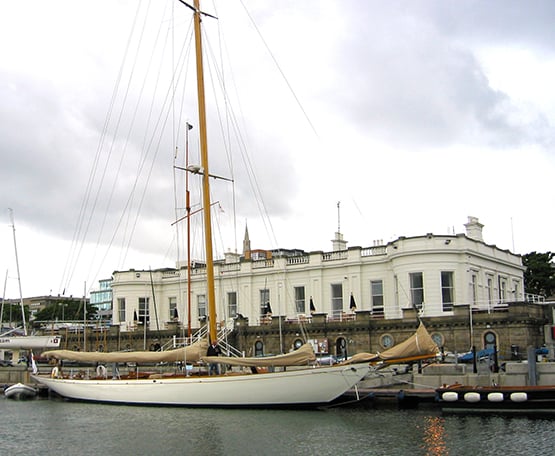There’s nothing that really compares with the annual Rolex Sydney Hobart Race. While most of the more-populated parts of the world in the Northern Hemisphere are in their midwinter shutdown, somnolent and sluglike in a festival of consumer excess, away south of the Equator one of the most magnificent city harbours in the world is exuberantly celebrating outdoors in all its midsummer glory. And then it tops out the party with one of world sailing’s great spectacles. W M Nixon anticipates the Rolex Sydney Hobart Race 2015, which starts in full daylight in Australia an hour after this is posted at midnight on Christmas Day in Ireland.
With the Yuletide festivities scarcely put away, a group of extreme boats at the peak end of the hundred foot size limit - every last one of them owned and sailed by larger-than-life characters – comes roaring out of Sydney’s glorious harbour at the head of a magnificent fleet, a colossally varied collection of 108 craft in which every crew reckons they’re in with a chance. For although line honours for the biggies are what captures the headlines, for the dyed-in-the-wool enthusiasts the only real trophy in the thrash to Hobart is the Tattersall’s Cup for the overall winner on IRC Handicap.
A severe weather forecast of three days ago has now been watered down, but there’ll still be plenty of breeze at some stages to be going along with. The start is expected to be in a moderate to fresh northeasterly, stronger outside once they begin making southing down the Tasman Sea, with most boats chasing that elusive race-winning south-going current which may be anything up to ten miles offshore.
Then everything changes in the weather situation with an active front rolling up from the south and southwest, with strong headwinds – maybe gusting to 45 knots in the front itself – providing atrocious wind-over-tide conditions with the under-lying south-going current. There’ll be a lot of Christmas dinners spread out over the ocean……After that, the winds are forecast to fall away as the bulk of the fleet get to the Bass Strait, but overall the pundits are reckoning boats in the 60ft to 75ft size range are looking to be the favoured cohort, while George David’s Rambler 88 – with the legendary Brad Butterworth in the afterguard – is now looking good to give the hundred footers more than a few tense moments.
By the time you’re likely to be reading this on Saturday morning, the drama will already be unfolding on the other side of the world, and all sorts of newsfeeds will be available for the best armchair offshore racing of the year. Yet as a Rolex Sydney-Hobart Race addict, I’ll readily concede that the last thing addiction provides is a clear picture, so you can expect this anticipation to be something of a rose-tinted view.

The Rolex Sydney-Hobart Race – a classic course which is staging its 71st edition as 2015 draws to a close
But that said, the Rolex Sydney Hobart Race of 2014 will take some beating. It provided the glorious battle for line honours between the new Comanche and the continually-evolving Wild Oats XI, veteran owner and local favourite Bob Oatley’s originally 98ft Reichel Pugh Wild Oats XI of 2005 vintage, but modified almost every year since, such that by December 2014 she was a hundred footer. Against her, the big new fat girl, Jim and Kristy Hinze Clark’s JK-designed total hundred footer Comanche, so big and beamy you could fit two Wild Oats into her and still have room to spare.
Yet although all the heavy metal seemed to be on Comanche’s side, including having the formidable Kenny Read as skipper, in the end the skinny girl wriggled her way through some awkward conditions which Comanche loathed, and wriggled to such good effect that Wild Oats took line honours.
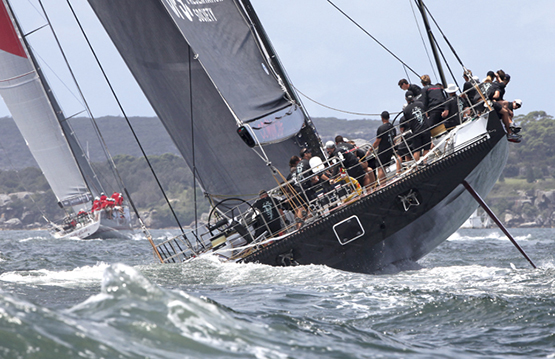
It’s reckoned you’d still have room to spare after fitting two of Wild Oats XI (left) into the very different hull of Comanche (right)
And then, to put the icing well and truly on the Hobart cake, as the various potential handicap winners were knocked out by the remorseless ticking of the clock, an overall winner emerged who was the very epitome of the true Australian ocean racing spirit. The veteran Farr 43 Wild Rose, owned successfully for many years by Roger Hickman, was on top of her immaculate form, and won the Tattersall’s Cup.
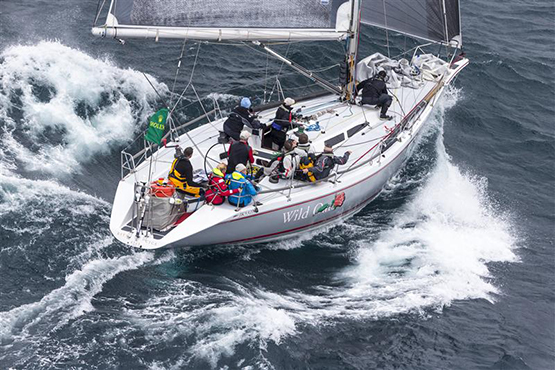
The true spirit of Australian offshore racing – Roger Hickman’s 28 year old Farr 43 Wild Rose (ex-Wild Oats) is defending champion in this year’s Rolex Sydney-Hobart race
And what was Wild Rose’s back-story? You just couldn’t make it up. She was one of the first boats to be called Wild Oats, brought to the Australian racing scene by a legendary entrepreneur called Bob Oatley who’d been so successful in business in Papua New Guinea that at one stage he was controlling 95% of the entire country’s GDP. And then, when local interests bought him out, he shifted operations back home to Australia, and created himself a new conglomerate business empire on an even large stage.
He found that the challenge of campaigning a serious offshore racer at the top end of the exuberant Australian offshore racing scene went perfectly with business. If the boat did well, enterprises like Robert Oatley Wines did well too. But regardless of that, it was fun. So although he’s looking into his 90s. Old Bob is as keen as ever on the whole crazy game, and with Mark Richards he has the perfect skipper/boat manager to maximize returns from the sheer entertainment provided by keeping Wild Oats XI up to the mark to fulfill her role as the people’s favourite.
The improvement project for 2015 was basically to re-position the mast. Now most folks, if they decide the mast is too far forward, they’d simply move it aft. But not the Wild Oats team. At its most fundamental, what they’ve done is keep the mast where it was, but they chopped off the bow - the chainsaw pix say it all - and then added a completely new longer slimmer bow. Try as you might, you can’t see the join…...

If you’re going to take the bow off the boat with a chainsaw, better make sure you’ve the owner there to do it with you. Mark Richards and Bob Oatley start the drastic surgery on Wild Oat XI
 You can’t even see the join….,Wild Oats with her new longer bow (right) with the old bow (left) kept in storage “in case the new one didn’t work” . But would you call that new stem a “clipper bow”?
You can’t even see the join….,Wild Oats with her new longer bow (right) with the old bow (left) kept in storage “in case the new one didn’t work” . But would you call that new stem a “clipper bow”?
Then, to keep her down to a hundred feet, they shortened and re-shaped the stern, such that the result of it all is the skinny girl is now super-slim. But thanks to the latest materials and some ferociously clever engineering and technology, Wild Oats is able to carry a mighty canting keel which keeps this torpedo of a boat upright and powering successfully along, in which mission she is further assisted by all sorts of canards and foils which can be deployed from multiple orifices.
Central to the whole story today, however, is the fact that the Hobart Race 2015 is the first real test of the completely re-vamped Wild Oats XI, and she’s yet again up against Comanche as a trial horse. But after such radical changes, naturally there are those who’ll question them. For a start, it has been noted that with the completely new bow section, the even longer bowsprit on WOXI is receiving additional support from a sort of solid strut from the stem which creates what some of us might describe as a clipper bow.
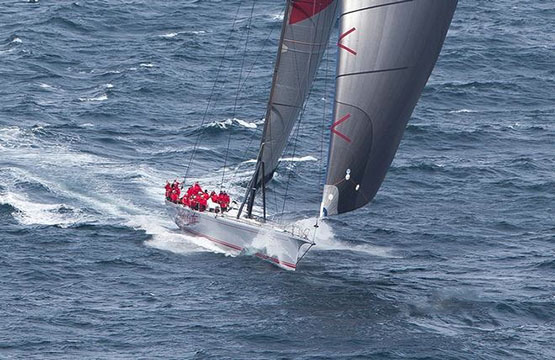
The re-configured Wild Oats XI is faster than ever, but what length is she?
And if you accept that this has indeed become a clipper bow of sorts, instead of a straight stem bow which happens to have a solid strut support for an unusually long bowsprit, then you’re accepting that Wild Oats’ hull has now become more than a hundred feet long, and therefore above the size limit for the Rolex Sydney-Hobart Race. At the time of writing, the Race Committee seemed to have accepted that Wild Oats still has a straight stem. But we can think of a few sea-lawyers who might possibly demur.
In the end, it’s a matter of definitions. Just recently, a Classic Boat magazine profile of the magnificent Fife-designed-and-built 1926 Fastnet Race line honours winner Hallowe’en revealed she is just over 71ft LOA, and something like 47ft when unladen on the waterline. The waterline length was fine, as it allowed some immersion in seagoing trim to stay within the Fastnet limit of 50ft LWL. But what’s with this 71ft plus in the LOA department, when the Fastnet Rule – set after the inaugural race of 1925 – clearly set the upper LOA limit at 70ft? Well, it seems that Hallowe’en is 70ft LOA on deck. And LOD was seen by many as being one and the same thing as LOA back in 1926. So now you know.
Hallowe’en, 1926 Fastnet Race Line Honours Winner, at the Royal Irish YC. While she was 70ft LOD to comply with the Fastnet Race maximum size, her hull LOA is actually slightly north of 71ft. Photo: W M Nixon
Whatever, this morning the one thing we’re starting to know is just how well the new-style Wild Oats is going, as there’s plenty of wind forecast for some stages, and the only test so far against other boats was in smooth water conditions in the Solas Big Boat Challenge a fortnight ago. This was a 14 mile round-the-buoys sprint within Sydney Harbour in which George David’s Rambler 88 was still right there with Wild Oats at the weather mark, but thereafter the Oats lengthened away in impressive style, while the other hundred footers weren’t really in contention with either her or Rambler.
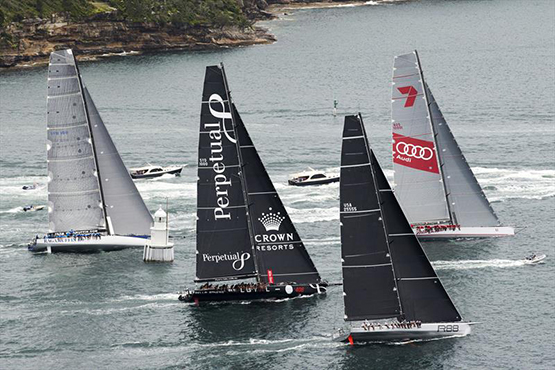
Racing in the Solas Big Boat Challenge on Sydney Harbour a fortnight ago. The new look Wild Oats XI is already showing ahead, but she had quite a job to shake off the smaller Rambler 88 (second right). There’s a lot of sailing history in this photo. Perpetual Loyal (second left) was formerly George David’s Rambler 100 which capsized at the Fastnet Rock in 2011 after snapping off her keel.
But of course Comanche very sensibly stayed away from the Solas Big Boat Chalenge. In-harbour contortions aren’t her thing at all. The big wide boat needs the wide open spaces of the clear ocean and the challenge of the 628 miles to Hobart. So it’s right now that the two monsters in their current form are at each other’s throats for the very first time, like a giant rattlesnake against a huge python. Jurassic Park goes sailing…….
After the hors d’euvre of the line honours battle, we then re-focus on the body of the fleet for the main course, and on the race tracker it’s fascinating to watch as fortunes wax and wane for different groups. But within each group, regardless of how they’re doing within the fleet at large, as the race progresses the group leaders become more clearly defined, but quite why and where it happens is sometimes only discernible in the post-race analysis.
For instance, last year the Dun Laoghaire crew of Barry Hurley and the Rumball brothers were right there on their First 40 with the comparably-rated Wild Rose as they approached the Bass Strait. But then with a couple of twists and turns of fortune Wild Rose got herself into a better rhythm, and there she was – gone – while the Irish crew slipped in the rankings.
The top Irish skipper within class in 2014 was Sean McCarter in the Clipper Division with Derry/Londonderry/Doire - he won the Clippers as they took it in as part of their multi-stage race round the world. The Clippers are there again this year in what is the most international fleet yet seen in the Sydney-Hobart, with a first-time strong mainland Chinese representation, particularly through Ark 323, their TP 52 whose home club is the Noah Sailing Club. If they do well, we can hope to find out how a challenger from the People’s Republic seems to draw so heavily on the Old Testament for the names of boat and club alike.

Will she finally find her true form? The Carkeek 60 Ichi Ban (Matt Allen), raced by Gordon Maguire, is in the size cohort favoured by the pundits to suit the forecast wind and weather.
Our own Gordon Maguire, winner overall in 1991 and 2012, is going again, and again it’s on Matt Allen’s Carkeek 60 Ichi Ban, which has a new rudder and other mods, and has been showing an improvement in form. And we now know that Maguire is going with the Carkeek 60 which is called Ichi Ban. Because you see, Matt Allen happens to have a TP 52 which is also called Ichi Ban, and though the modified Carkeek 60 seemed to have found better form to win the Cabbage Tree Island race at the end of November, even then Allen wouldn’t say which Ichi Ban would do the Hobart Race. But with the wind pattern forecast, it will be the Carkeek, indeed she is now rated one of the favourites if the weather does as the gurus say it will.
Another boat of special Irish interest is the completely new Wicklow-designed Mills 45 Concubine, built in Dubai for South Australian sailor Jason Ward of Adelaide, and only afloat since November 11th. So she has scarcely been sailing seriously for much more than a wet week. But the word is the boat’s potential is enormous. And simply seeing how she performs in this ultimate test tank of modern middle distance offshore racing is going to be top of the interest levels for the next few days.
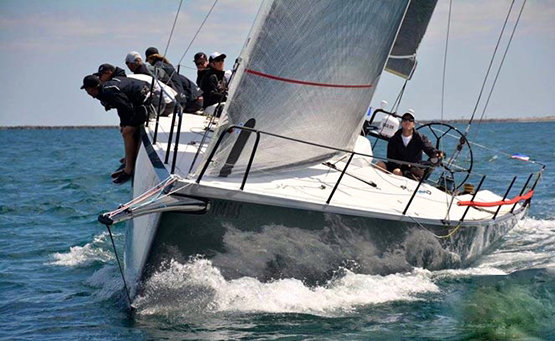
Her lines were drawn in the midst of the Wicklow countryside – the new Mark Mills-designed 45ft Concubine will have her first real test in the Hobart Race
For although the Hobart Race is of rather more recent date than the other classics such as the Bermuda Race and the Fastnet, they are biennial whereas the Sydney-Hobart has been an annual event ever since being founded in 1945, and thus has built up its mystique more quickly. As a result, some devotees log up an astonishing number of races to Hobart, and this year Tony Cable will be doing his 50th . This time round – as it has been for the past four Hobarts – he’s aboard Damien Parkes’ JV52 Duende, but he has been on many different boats, and in all he has raced to Hobart with 308 different crewmates over the years, so they’re going to need a very large premises for his reunion.
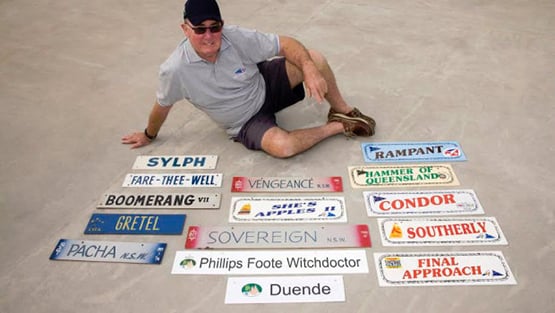
Tony Cable is doing his 50th Sydney-Hobart Race – these are the name plates of the 15 boats he has sailed on
The Sydney-Hobart Race started at the end of World War 2 when Sydney cruising men asked the great offshore racing legend Captain John Illingworth RN – who happened to be running the navy yard at Wooloomoolo at the time – if he’d be interested in a cruise-in-company down to Hobart over Christmas. He said he’d be interested in the offshore passage to Hobart, but only if they made it a race.
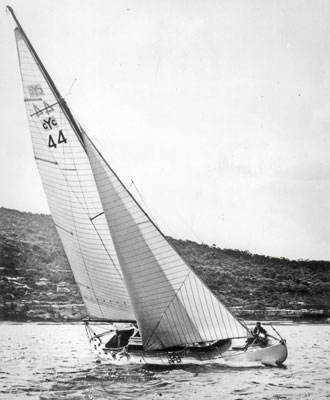
Rani (John Illingworth) was winner of the first Sydney-Hobart race in 1945
By the time it got going, he’d acquired himself a little locally designed and built sloop called Rani. Despite having one of the smallest boats in the fleet, Illingworth battled on through a proper Southerly Buster and then another gale, before he finally got to Hobart expected to be dog last in this new race, as Rani’s radio had packed it in shortly after the start. Thus they’d no word of anyone else at all, while they themselves had been posted missing.
But he found he was twenty hours ahead of the next boat on the water. He’d won overall by hours or even days, and it was a long time before all the fleet had got in. Every other entry had sought shelter of some sort. And one boat had even gone into port so that her crew could go to the cinema to pass the time before racing on south once the weather had improved. Be assured that things are different these days in the Rolex Sydney-Hobart Race

Captain John Illingworth looking more than somewhat weatherbeaten at the finish of the first Hobart race in 1945, which he won. He went on to win the Fastnet Race overall twice (in 1947 and 1949) with Myth of Malham.



























